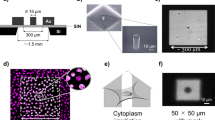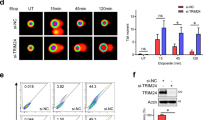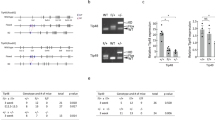Abstract
The gene mutated in the autosomal recessive disorder ataxia telangiectasia (AT), designated ATM (for 'AT mutated'), is a member of a family of phosphatidylinositol-3-kinase-like enzymes that are involved in cell-cycle control, meiotic recombination, telomere length monitoring and DNA-damage response1–4. Previous results have demonstrated that AT cells are hypersensitive to ionizing radiation5–7 and are defective at the Gl/S checkpoint after radiation damage8–10. Because cells lacking the protein tyrosine kinase c-Abl are also defective in radiation-induced Gl arrest11, we investigated the possibility that ATM might interact with c-Abl in response to radiation damage. Here we show that ATM binds c-Abl constitutively in control cells but not in AT cells. Our results demonstrate that the SH3 domain of c-Abl interacts with a DPAPNPPHFP motif (residues 1,373–1,382) of ATM. The results also reveal that radiation-induction of c-Abl tyrosine kinase activity is diminished in AT cells. These findings indicate that ATM is involved in the activation of c-Abl by DNA damage and this interaction may in part mediate radiation-induced Gl arrest.
This is a preview of subscription content, access via your institution
Access options
Subscribe to this journal
Receive 51 print issues and online access
$199.00 per year
only $3.90 per issue
Buy this article
- Purchase on Springer Link
- Instant access to full article PDF
Prices may be subject to local taxes which are calculated during checkout
Similar content being viewed by others
References
Savitsky, K. et al. A single ataxia telangiectasia gene with a product similar to PI-3 kinase. Science 268, 1749–1753 (1995).
Zakian, V. A. ATM-related genes: what do they tell us about functions of the human gene? Cell 82, 685–687 (1995).
Lavin, M. F. et al. Relationship of the ataxia-telangiectasia protein ATM to phosphoinositide 3-kinase. Trends Biochem. Sci. 20, 382–383 (1995).
Jackson, S. P. Cancer predisposition. Ataxia-telangiectasia at the crossroads. Current Biol. 5, 1210–1212 (1995).
Taylor, A. M. et al. Ataxia telangiectasia: a human mutation with abnormal radiation sensitivity. Nature 274, 484–486 (1975).
Chen, P. C., Lavin, M. F., Kidson, C. & Moss, D. Identification of ataxia telangiectasia heterozygotes, a cancer prone population. Nature 258, 427–429 (1975).
Paterson, M. C., Anderson, A. K., Smith, B. P. & Smith, P. J. Enhanced radiosensitivity of cultured fibroblasts from ataxia telangiectasia heterozygotes manifested by defective colony-forming ability and reduced DNA repair replication after hypoxic gamma-irradiation. Cancer Res. 39, 3725–3734 (1979).
Kastan, M. B. et al. A mammalian cell cycle checkpoint pathway utilizing p53 and GADD45 is defective in ataxia-telangiectasia. Cell 71, 587–597 (1992).
Khanna, K. K. & Lavin, M. F. Ionizing radiation and UV induction of p53 protein by different pathways in ataxia-telangiectasia cells. Oncogene 8, 3307–3312 (1993).
Khanna, K. K. et al. Nature of G1/S cell cycle checkpoint defect in ataxia-telangiectasia. Oncogene 11, 609–618 (1995).
Yuan, Z.-M. et al. Role for c-Abl tyrosine kinase in growth arrest response to DNA damage. Nature 382, 272–274 (1996).
Telatar, M. et al. Ataxia-telangiectasia: mutations in ATM cDNA detected by protein-truncation screening. Am. J. Hum. Genet. 59, 40–44 (1996).
Uziel, T. et al. Genomic organization of the ATM gene. Genomics 33, 317–320 (1996).
Pawson, T. Non-catalytic domains of cytoplasmic protein-tyrosine kinases: regulatory elements in signal transduction. Oncogene 3, 491–495 (1988).
Pecker, L. et al. Identification and chromosomal localization of Atm, the mouse homolog of the ataxia-telangiectasia gene. Genomics 35, 39–45 (1996).
Kharbanda, S. et al. The stress response to ionizing radiation involves c-Abl-dependent phosphorylation of SHPTP1. Proc. Natl Acad. Sci. USA 93, 6898–6901 (1996).
Kharbanda, S. et al. Activation of the c-Abl tyrosine kinase in the stress response to DNA-damaging agents. Nature 376, 785–788 (1995).
Ren, R., Ye, Z.-S. & Baltimore, D. Abl protein-tyrosine kinase selects the Crk adapter as a substrate using SH3-binding sites. Genes Dev. 8, 783–795 (1994).
Shafman, T. et al. Defective induction of stress-activated protein kinase activity in ataxia-telangiectasia cells exposed to ionizing radiation. Cancer Res. 55, 3242–3245 (1995).
Zhang, N. et al. Correction of theataxia-telangiectasa cellular phenotype with full-length ATM cDNA. Proc. Natl Acad. Sci. USA (in the press).
Rudolph, N. S. & Latt, S. A. Flow cytometric analysis of X-ray sensitivity in ataxia telangiectasia. Mutat. Res. 211, 31–41 (1989).
Beamish, H. & Lavin, M. F. Radiosensitivity in ataxia-telangiectasia: anomalies in radiation-induced cell cycle delay. Int. J. Radiat. Biol 65, 175–184 (1994).
Frangioni, J. V. & Neel, B. G. Solubilization and purification of enzymatically active glutathione S-transferase (pGEX) fusion proteins. Anal. Biochem. 210, 179–187 (1993).
Gilad, S. et al. Ataxia-telangiectasia: founder effect among North African Jews. Hum. Mol Genet. 5, 2033–2037 (1996).
Watters, D. et al. Cellular localisation of the ataxia-telangiectasia (ATM) gene product and discrimination between mutated and normal forms. Oncogene 14, 1911–1921 (1997).
Houldsworth, J. & Lavin, M. F. Effect of ionizing radiation on DNA synthesis in ataxia telangiectasia cells. Nucleic Acids Res. 8, 3709–3720 (1980).
Author information
Authors and Affiliations
Rights and permissions
About this article
Cite this article
Shafman, T., Khanna, K., Kedar, P. et al. Interaction between ATM protein and c-Abl in response to DNA damage. Nature 387, 520–523 (1997). https://doi.org/10.1038/387520a0
Received:
Accepted:
Issue Date:
DOI: https://doi.org/10.1038/387520a0
This article is cited by
-
Exposure of the cytoplasm to low-dose X-rays modifies ataxia telangiectasia mutated-mediated DNA damage responses
Scientific Reports (2021)
-
ABL1-dependent OTULIN phosphorylation promotes genotoxic Wnt/β-catenin activation to enhance drug resistance in breast cancers
Nature Communications (2020)
-
Telomere dysfunction activates YAP1 to drive tissue inflammation
Nature Communications (2020)
-
Imatinib independent aberrant methylation of NOV/CCN3 in chronic myelogenous leukemia patients: a mechanism upstream of BCR-ABL1 function?
Cell Communication and Signaling (2019)
-
Radiation-dose-dependent functional synergisms between ATM, ATR and DNA-PKcs in checkpoint control and resection in G2-phase
Scientific Reports (2019)
Comments
By submitting a comment you agree to abide by our Terms and Community Guidelines. If you find something abusive or that does not comply with our terms or guidelines please flag it as inappropriate.



